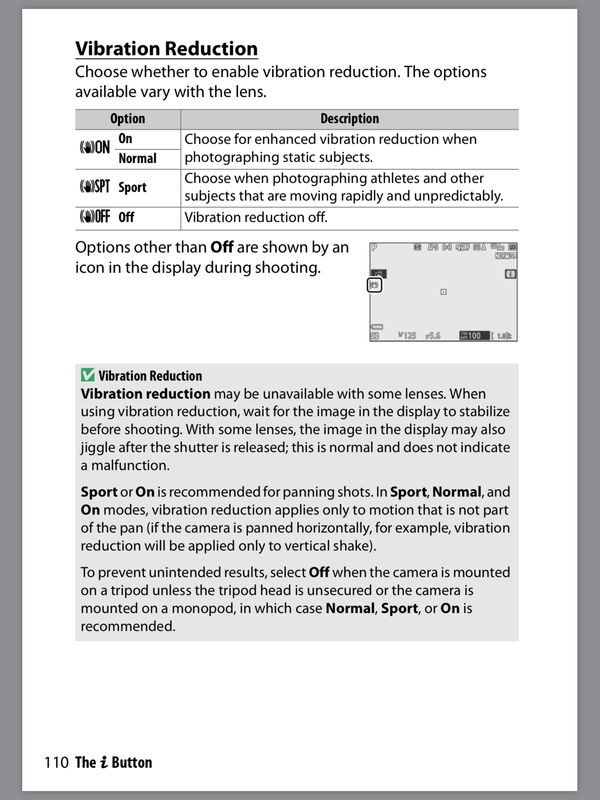VR For Panning
Dec 5, 2018 11:35:08 #
This is a question that's been bugging me for a while. On both my Sigma and Tamron 150x600MM lenses there is a VR switch with three choices: one for stationary subjects, a second for moving subjects (panning), and a third for when you are on a moving platform of some type. Most experts say to turn VR off when the shutter speed exceeds 1/500. Usually, if I'm after BIFs, my shutter speed will far exceed 1/500. My question pertains to the panning mode (second setting) VR. Should the VR be set to that position if trying to captures BIFs regardless of how high the shutter speed is? If not, why do they build it into each of the lenses at what must be some additional cost?
Dec 5, 2018 11:41:32 #
What experts say to turn off VR when above 1/500th? I always leave it on when hand held. On a tripod, leaving VR on can affect your image.
Dec 5, 2018 11:44:37 #
The experts design the lens and provide content for the user manual. That should be your source for expert usage advice.
Dec 5, 2018 11:50:00 #
Perhaps. But I've yet to see anything written about this specific question. I have looked, but admittedly not very hard.
CHG_CANON wrote:
The experts design the lens and provide content for the user manual. That should be your source for expert usage advice.
Dec 5, 2018 12:59:23 #
saxman71 wrote:
I don't care what some "experts" saying, I turn VR/IS to off, whenever I shoot any type of action handheld (such as BIF, sports, or any other type), because that's what works best for me!This is a question that's been bugging me for a wh... (show quote)
Dec 5, 2018 13:39:23 #
That then begs the question: Have you tried it with VR both off and on to determine that is what works best for you?
speters wrote:
I don't care what some "experts" saying, I turn VR/IS to off, whenever I shoot any type of action handheld (such as BIF, sports, or any other type), because that's what works best for me!
Dec 5, 2018 14:29:52 #
On Nikon (and I assume sigma in the "panning" mode), when you pan the camera the VR system only adjusts for errors opposite the pan. So, if you're panning horizontally, it's only adjusting for vertical movement errors. This can prove handy if you're panning at really slow shutter speeds, where you can track the bird and blur the background. When your shutter speed gets higher (say, over 1/1500th) it's probably no longer giving you any benefit.
However, when to shut off VR does vary by lens. My 500PF and 600 F4E don't care if I leave VR on all the time, but my 200-500 sees a noticeable drop in acuity over 1/500th. Of course, it's almost never documented by the manufacturer, so your best bet is to test it yourself and compare.
However, when to shut off VR does vary by lens. My 500PF and 600 F4E don't care if I leave VR on all the time, but my 200-500 sees a noticeable drop in acuity over 1/500th. Of course, it's almost never documented by the manufacturer, so your best bet is to test it yourself and compare.
Dec 5, 2018 14:41:45 #
As I understand it, the way VR works is that the lens contains an accelerometer sensor. That sensor is used to move one of the lens elements in the direction of motion in such a way as to offset the lens motion. (I suspect that the lens motion is angular rather than translational just because it could probably provide faster response). The various modes modify the reaction depending on whether it's shake or constant velocity.
The sampling of the accelerometer is around 1 KHz. The nyquist frequency is therefore about 500 HZ, which is where you get the 1/500 second number. Faster shutter speeds will not see any shake reduction due to the VR.
Since the VR depends on motion of an internal lens element, there can be momentary loss of acuity while the element is in motion. In the long term that should average out, but at fast shutter speeds, you take whatever you get. That means your acuity could vary between shots with VR on with a fast shutter.
I am not a lens engineer, so the above description represents my inferences from various things I've read about VR.
The sampling of the accelerometer is around 1 KHz. The nyquist frequency is therefore about 500 HZ, which is where you get the 1/500 second number. Faster shutter speeds will not see any shake reduction due to the VR.
Since the VR depends on motion of an internal lens element, there can be momentary loss of acuity while the element is in motion. In the long term that should average out, but at fast shutter speeds, you take whatever you get. That means your acuity could vary between shots with VR on with a fast shutter.
I am not a lens engineer, so the above description represents my inferences from various things I've read about VR.
Dec 5, 2018 14:51:31 #
Thank you Steve and DirtFarmer for replying and giving me your informed opinions to consider.
Dec 5, 2018 14:52:48 #
DirtFarmer wrote:
As I understand it, the way VR works is that the l... (show quote)
For what it's worth, that is my understanding of it as well, however, the source of the info is well over a decade old now. My belief is that at least some of the newer lenses sample at faster than 1KHz, which is why some seem good at faster speeds, others, not so much.
Dec 6, 2018 06:42:15 #
catchlight..
Loc: Wisconsin USA- Halden Norway
Set VR for pan and as low as 1/80th sec. Use 150mm from the lens to get the most effect. You will get the pan blur and wheel spin effects at that setting. The longer the focal length and the faster the shutter speed, the less you will accomplish. Experiment at ISO 100, 1/200 sec and what ever f stop required to start. If your steady in your pan motion you can get down below the focal length rule of 150th.
Dec 6, 2018 11:20:22 #
rgrenaderphoto wrote:
What experts say to turn off VR when above 1/500th? I always leave it on when hand held. On a tripod, leaving VR on can affect your image.
Correct, leave VR on at all speeds if panning or doing BIF handheld . Yes turn it off when using a tripod.
Dec 6, 2018 11:33:01 #
On some systems (Panasonic, for one), the Panning setting works quite well for video of horizontally moving subjects. Most video is recorded with a relatively slow shutter speed of 1/48 or 1/50 second (for 24 fps filmmakers or 1/50 for 25 fps European video standards), 1/60 (for 29.98/30 fps American TV standards), 1/120, or 1/125 second (for 59.6/60 fps digital video). (The unusual speeds result from using a 180 degree shutter angle setting instead of fractional shutter speeds — something you can do on the filmmaker-savvy GH4, GH5, or GH5s).
Obviously, most image stabilizing systems provide the greatest benefit at slower speeds, for both stills and video. With most systems, there is little or no IMAGING benefit at speeds faster than 1/500. However, the stabilizer can help you hold a long lens steady enough to *compose* your scene, regardless of the shutter speed you'll use.
Stabilization schemes can vary wildly in their capabilities. Before you buy any stabilized lens or body, read and watch reviews and test reports and comparisons. There are a few "lazy dogs" out there. Two recent YouTube reviews of the latest Nikon, Tamron, and Sigma 24-70mm f/2.8 zoom lenses both concluded that the Sigma lens stabilizer does almost nothing.
In general, In-Body Image Stabilization works best at focal lengths under 200mm full frame equivalent (that's 150mm on APS-C or 100mm on Micro 4/3). In-Lens Image Stabilization works best with longer telephotos. Dual IS schemes coordinate both approaches for the best of both worlds.
Obviously, most image stabilizing systems provide the greatest benefit at slower speeds, for both stills and video. With most systems, there is little or no IMAGING benefit at speeds faster than 1/500. However, the stabilizer can help you hold a long lens steady enough to *compose* your scene, regardless of the shutter speed you'll use.
Stabilization schemes can vary wildly in their capabilities. Before you buy any stabilized lens or body, read and watch reviews and test reports and comparisons. There are a few "lazy dogs" out there. Two recent YouTube reviews of the latest Nikon, Tamron, and Sigma 24-70mm f/2.8 zoom lenses both concluded that the Sigma lens stabilizer does almost nothing.
In general, In-Body Image Stabilization works best at focal lengths under 200mm full frame equivalent (that's 150mm on APS-C or 100mm on Micro 4/3). In-Lens Image Stabilization works best with longer telephotos. Dual IS schemes coordinate both approaches for the best of both worlds.
Dec 6, 2018 13:51:12 #
IDguy
Loc: Idaho
saxman71 wrote:
This is a question that's been bugging me for a wh... (show quote)
First, the authors who tell you to turn off VR when shutter speed is above 1/500 are wrong. You won’t find that in any camera or lens manual. VR is about camera movement. It has nothing to do with shutter speed. In all cases it helps stabilize the image in the viewfinder when handheld.
It used to be that all lens manuals recommended turning off VR when using a tripod. As VR has improved that is no longer universal. For example the Nikon 200-500 manual tells you to leave it on when using a monopod or tripod, but to also test with it off for your tripod.
The plot has just thinkened for me with the Z6, which has sensor stabilization. See pic for what it says. Nothing about when I’m using lenses that also have VR. 🤔

Dec 6, 2018 14:37:46 #
rgrenaderphoto wrote:
What experts say to turn off VR when above 1/500th? I always leave it on when hand held. On a tripod, leaving VR on can affect your image.
Here:
http://www.dslrbodies.com/lenses/lens-articles/lens-technique/all-about-nikon-vr.html
If you want to reply, then register here. Registration is free and your account is created instantly, so you can post right away.




